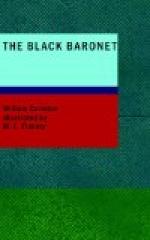PREFACE.
The incidents upon which this book is founded seem to be extraordinary and startling, but they are true; for, as Byron says, and as we all know, “Truth is strange—stranger than Fiction.” Mr. West, brother to the late member from Dublin, communicated them to me exactly as they occurred, and precisely as he communicated them, have I given them to the reader, at least, as far as I can depend upon my memory. With respect, however, to his facts, they related only to the family which is shadowed forth under the imaginary name of Gourlay; those connected with the aristocratic house of Cullamore, I had from another source, and they are equally authentic. The Lord Dunroe, son to the Earl of Cullamore, is not many years dead, and there are thousands still living, who can bear testimony to the life of profligacy and extravagance, which, to the very last day of his existence, he persisted in leading. That his father was obliged to get an act of Parliament passed to legitimize his children, is a fact also pretty well known to many.
At first, I had some notion of writing a distinct story upon each class of events, but, upon more mature consideration, I thought it better to construct such a one as would enable me to work them both up into the same narrative; thus contriving that the incidents of the one house should be connected with those of the other, and the interest of both deepened, not only by their connection, but their contrast. It is unnecessary to say, that the prototypes of the families who appear upon the stage in the novel, were, in point of fact, personally unknown to each other, unless, probably, by name, inasmuch as they resided in different and distant parts of the kingdom. They were, however, contemporaneous. Such circumstances, nevertheless, matter very little to the novelist, who can form for his characters whatsoever connections, whether matrimonial or otherwise, he may deem most proper; and of this, he must be considered himself as the sole, though probably not the best, judge. The name of Red Hall, the residence of Sir Thomas Gourlay, is purely fictitious, but not the description of it, which applies very accurately to a magnificent family mansion not a thousand miles from the thriving little town of Ballygawley. Since the first appearance, however, of the work, I have accidentally discovered, from James Frazer’s admirable. “Hand-book for Ireland,” the best and most correct work of the kind ever published, and the only one that can be relied upon, that there actually is a residence named Red Hall in my own native county of Tyrone. I mention this, lest the respectable family to whom it belongs might take offence at my having made it the ancestral property of such a man as Sir Thomas Gourlay, or the scene of his crimes and outrages. On this point, I beg to assure them that the coincidence of the name is purely accidental, and that, when I wrote the novel, I had not the slightest notion that




